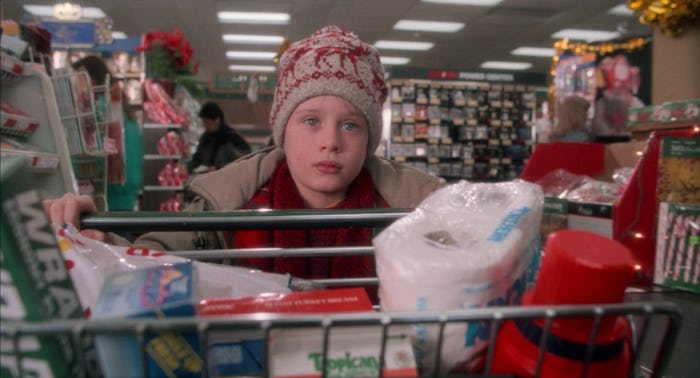Ahhhhhhh!

Here’s What Kevin McCallister's Groceries In Home Alone Would Cost In 2023
Kevin McAllister spent $19.83 for groceries in 1990. One TikTok user found that the same order is more than three times as much in 2023.
Of all of the Christmas movies we get excited to watch every December, Home Alone is definitely near the top of our list. It’s not just the nostalgia factor; this movie is extremely clever, and it feels like there’s always some new detail we can find. Like the fact that Kevin’s dad accidentally throws away his plane ticket during the big family dinner scene. This season, with grocery bills growing conspicuously larger, some have been especially interested in Kevin’s own shopping trip, with some even calculating what Kevin’s Home Alone grocery bill would come to in 2023.
A quick recap if you don’t know what we’re talking about: About halfway through the movie, Kevin (famously home alone) decides to make a grocery store run. At check-out, Sally, the cashier is amused but suspicious of the precocious 8-year-old, who satisfies her questions about the fact that he is not in the presence of an adult (mom in the car, dad at work). The scene is meant to demonstrate the fact that Kevin, disparaged as “les incompetent” by his sister Linnie earlier in the film (baselessly, I might add!), is actually far more self-sufficient than anyone realized. His purchases are practical and well thought out and he handles the interaction with Sally very maturely.
But what 2023 Home Alone audiences are interested in is the price tag: under $20 for...
- milk (his mom had specifically mentioned the milk was going bad earlier in the movie. See? Clever!)
- orange juice
- plastic food wrap
- two frozen dinners
- laundry detergent
- bread
- dryer sheets
- toilet paper
- a package of toy soldiers (“for the kids”)
TikTok user @sellitlikelyons was among those who have broken down the order. Searching for the the same or similar items online at Target, they calculated the grand total: $68.99. Minus the $1 off coupon Kevin offered Sally the Cashier? Well, @sellitlikelyons figured that was $67.99 but if you adjust the dollar for inflation that’d be $2.29 so more like $66.70. (Though I don’t know about you, but I haven’t seen any $2.29 off coupons for name brand OJ any time recently...)
The comments were a mix of jokes, commiserating, and commiserating jokes. There was also a lot of quibbling over how @sellitlikelyons calculated his total, observing that Target is more expensive than other grocery stores which is maybe true but probably not enough to make a huge difference.
“Kevin would have been eating baked potato and water till we got home cause damn,” marveled one.
“I’m still shocked when I buy 4 things and my total is $100,” bemoaned another. “I remember being able to buy groceries for a month with $100.”
A third was clearly #TeamSally.
“I bet the cashiers wage is still the same in 2023,” they quipped.
For many, surely the takeaway will be a rueful “Well that’s inflation for you!” and, yeah, a lot of it is. However! When you pop $19.83 into the Bureau of Labor Statistics’ Consumer Price Index inflation calculator (a site I visit regularly, because Boomers won’t stop belittling subsequent generations for our lack of economic prosperity and I need data), I get $45.51.
Which is a big jump, no question about it, but that leads us to the other culprit of this fact: food companies charging significantly more for the same items than they were (relatively speaking) in 1990. This isn’t conjecture; according to the United States Department of Agriculture (USDA), last year household food prices jumped more than 11% compared to the year before, the biggest jump since 1974, per reporting from Vox. Prices continued to rise throughout 2023, not as much as in 2022, but still at above historical-average rates.
In this same period, corporate profits from large food companies soared. From 2022 to earlier this year, Time reports that Kraft-Heinz, the company that makes Kevin’s “highly nutritious, microwavable macaroni and cheese dinner,” made $887 million in net profits up from $255 million. That’s a 448% increase over the course of the year.
What will $19.83 in 1990 money buy us next year? I’m not sure, but let’s just say it’s making me understand why the Wet Bandits wanted to rob all those houses...
This article was originally published on